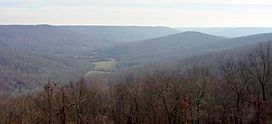Lost Cove, Tennessee facts for kids
Quick facts for kids Lost Cove |
|
|---|---|

Upper Lost Cove from Sewanee, Tennessee. The Saddle is in the distance above Lost Cove Cave
|
|
| Floor elevation | 1,000 feet (300 m) |
| Length | 7 miles (11 km) North to South |
| Width | 1 mile (1.6 km) |
| Geography | |
| Location | Franklin County, Tennessee |
| Population centers | Sherwood, Sewanee |
| Traversed by | Tennessee State Route 56 |
Lost Cove is a beautiful, hidden valley in southern Tennessee. It's close to the Alabama border. This special place is known for its interesting history. Native Americans and early settlers once lived here. It also has amazing natural features like Caves and Sinkholes.
Contents
Why is it Called Lost Cove?
This valley was first called Lost Creek Cove in the early 1800s. The name came from a small river called Lost Creek. Over time, people shortened the name to Lost Cove.
The creek got its name because it seems to appear in the northern part of the valley. This is below Sewanee, Tennessee. Then, it disappears (or gets lost) into a large hole called the Big Sink in the south.
There's another story about the name. In the mid-1800s, a visitor got lost in the valley. They wandered for two days among the thick Canebrakes (tall grasses). After that, they supposedly named it the Lost Cove.
Exploring Lost Cove's Geography
Lost Cove was formed by something called Karst erosion. This is a common process in areas like the Cumberland Plateau. It happens when water dissolves rock, creating caves and sinkholes.
The valley stretches about 7 miles (11 km) long. It goes from Sewanee down to the Crow Creek Valley in Sherwood, Tennessee.
Northern and Southern Sections
A partially eroded ridge looks like a "Saddle." This saddle divides the cove into two parts. These parts are the northern and southern sections. The Big Sink and Lost Cove Cave are also at this dividing point.
The northern part of the cove is quite isolated. Mountains surround it on the north, west, and east. The Saddle forms a natural barrier to the south. Because of this, people living there had to travel over these mountains. This made them very self-sufficient.
The southern part of the cove is easier to reach. It opens up towards the town of Sherwood.
A Look at Lost Cove's History
Long before European settlers arrived, Native Americans lived in Lost Cove. They built homes and lived off the land.
Later, European settlers came and built their own communities. They constructed houses, barns, and sawmills. They also built a church, a school, and cemeteries. Today, only a few of these old structures remain.
Evidence of Native American life has been found in Lost Cove Cave. There's a special spot inside the cave called the Indian Room.
Lost Cove in Books and Stories
Lost Cove has appeared in several books and legends.
Stories from the Cove
In his book Lost Cove, George Spain shares a family's history. It tells the story of five generations who lived in the cove. They were largely cut off from the outside world.
Arthur Ben Chitty, a historian from the University of the South, wrote Sewanee Sampler. In it, he tells a story about the cove. It's possibly a legend, but it's interesting!
The story says that some people bought the 18,000-acre cove. They thought they could turn it into a big lake. They didn't know that the many sinkholes and caves would make this impossible. Later, they had to sell the land back to the locals. They lost a lot of money!
Novelist Walker Percy also mentions Lost Cove often in his books. You can find it in Lost in the Cosmos and Love in the Ruins.
Gallery






